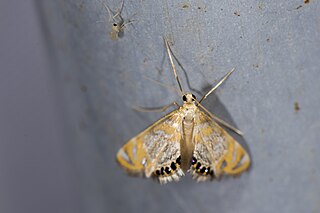
Crambidae comprises the grass moth family of lepidopterans. They are variable in appearance, with the nominal subfamily Crambinae taking up closely folded postures on grass stems where they are inconspicuous, while other subfamilies include brightly coloured and patterned insects that rest in wing-spread attitudes.

The Pyraloidea are a moth superfamily containing about 16,000 described species worldwide, and probably at least as many more remain to be described. They are generally fairly small moths, and as such, they have been traditionally associated with the paraphyletic Microlepidoptera.

Nymphicula is a genus of moths of the family Crambidae.
Etielloides kogii is a species of snout moth in the genus Etielloides. It was described by Hiroshi Yamanaka in 1998 and is known from China and Japan.

Phycitodes subcretacella is a species of snout moth. It was described from Japan, but is also found in Spain and Russia.

Elophila turbata is a moth in the family Crambidae found in Africa and Asia. It was first described by the English entomologist Arthur Gardiner Butler in 1881 from a specimen found in Yokohama, Japan.
Nymphicula albibasalis is a moth in the family Crambidae. It was described by Yoshiyasu in 1980. It is found in Japan.
Hendecasis apiciferalis is a moth in the family Crambidae. It is found in China (Shanghai), Russia and Japan.
Evergestis junctalis is a moth in the family Crambidae. It was described by Warren in 1892. It is found in Japan and on the Kuriles.
Acropentias aureus is a moth in the family Crambidae. It was described by Arthur Gardiner Butler in 1878. It is found in Japan, China, Taiwan and the Russian Far East.
Donacaula dodatellus is a moth in the family Crambidae. It was described by Francis Walker in 1864. It is found in China (Yunnan), Japan, India, Myanmar, Sri Lanka, the Philippines and on Sumatra.
Leechia bilinealis is a moth in the family Crambidae. It was described by South in 1901. It is found in Hubei in China and in Japan.

Leechia sinuosalis is a moth in the family Crambidae. It was described by South in 1901. It is found in China, Japan and Taiwan.
Patissa fulvosparsa is a moth in the family Crambidae. It was described by Arthur Gardiner Butler in 1881. It is found in China, Taiwan, Japan, Korea, India and Indonesia.
Patissa minima is a moth in the family Crambidae. It was described by Hiroshi Inoue in 1995. It is found in China and Japan.
Scirpophaga gotoi is a moth in the family Crambidae. It was described by Angoon Lewvanich in 1981. It is found in the Chinese provinces of Jiangsu and Guangdong and in Japan.
Scirpophaga lineata is a moth in the family Crambidae. It was described by Arthur Gardiner Butler in 1879. It is found in China, Japan, India, Malaysia and Indonesia.
Scirpophaga parvalis is a moth in the family Crambidae. It was described by Alfred Ernest Wileman in 1911. It is found in China, Japan and Korea.

Glyphodes pyloalis, the lesser mulberry snout moth, lesser mulberry pyralid or beautiful glyphodes moth, is a moth in the family Crambidae. It was described by Francis Walker in 1859. It is found in Iran, China, Japan, India, Indonesia (Sumatra), Sri Lanka, Taiwan, the Democratic Republic of the Congo, Equatorial Guinea, Mozambique and North America, where it has been recorded from Florida, Maryland, North Carolina, South Carolina and Virginia.
Nacoleia inouei is a moth in the family Crambidae. It was described by Hiroshi Yamanaka in 1980. It is found in Japan and Korea.





